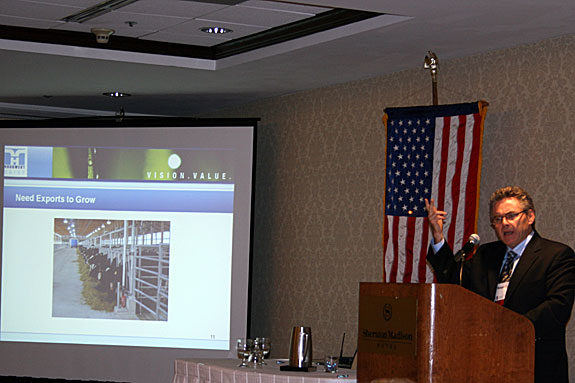The business of dairying includes more than feeding and milking the bovine animal. At a time when the government is regulating the environment and labor force, consumers want to be informed and prices – paid and received – are more volatile than ever, the Professional Dairy Producers of Wisconsin (PDPW) took two days to get briefed on what is happening in the industry.
The Dairy Policy Summit was held Oct. 27-28 at the Sheraton Hotel in Madison, Wisconsin. More than 120 dairy producers, allied industry and government officials gathered to hear the latest on topics that affect their businesses.
The event started with Jordan Lamb, an attorney with DeWitt Ross & Stevens , and Bruce Baker, administrator of the Division of Water for Wisconsin’s Department of Natural Resources , briefing the crowd on revisions to water rules in the state. Wisconsin is the only state with enforceable nonpoint source performance standards and prohibitions. New revisions to that rule (NR 151) became final on Oct. 1. Revisions include a new total maximum daily load (TMDL) standard, a new phosphorus index (PI) performance standard for worked ground and pastures, and a new tillage setback. Lamb and Baker also discussed point source rule revisions, the Great Lakes Compact and groundwater use regulations that are on the horizon.
When it comes to consumer dialog, are you really listening to what they are saying? Are you sharing the message they want to hear? Linda Wenck from Morgan&Myers , along with a dairy producer panel consisting of Pam Selz-Pralle, Charles Crave and Nik Sutter, shared what she learned from consumer focus groups in Illinois. Based on their responses she is helping agricultural groups in Illinois tailor their messaging to better educate consumers about modern agriculture and connect them back to the farmer again.
The importance of consumer messaging became even more apparent when Chad Gregory, United Egg Producers , and John Miles, Land O’Lakes , spoke of how activist groups like HSUS and PETA are working against agriculture. Miles also discussed how Land O’Lakes is hoping to debunk HSUS claims by participating in the National Dairy FARM Program .
Dr. Mark Stephenson, director of dairy policy analysis at the University of Wisconsin – Madison delved deeper into the dairy pricing issue with outcomes from modeling the Foundation for the Future and Costa-Sanders plans to combat volatility in the marketplace.
Dalyn Dye with Hoogwegt U.S. brought dairying to the global scale in his presentation on the global marketplace. He stressed how, with the right incentives, the U.S. could benefit from selling dairy products consistently to world market.

Erich Straub from Immigration Attorney LLC reviewed the history of immigration law. Since being declared the United States of America our country has tried to withhold citizenship from convicts, prostitutes, Chinese, idiots, paupers, epileptics, Asians, eastern and southern Europeans, Catholics and Japanese – just to name a few. Immigration legislation known as AgJOBS has been proposed to help provide temporary and permanent status to those immigrants the agriculture industry depends on. It has received overwhelming support, yet typically does not pass because it is tied to larger legislation. “The support is there,” Straub said. “The political will is not.” Perhaps things will change with this month’s election.
Wisconsin’s unique livestock facility siting rule is undergoing its first four-year review. Mike Murray with the Wisconsin Department of Agriculture, Trade and Consumer Protection discussed how this evaluation was written into the law to keep the rule current and how the political process of revisions will occur. The Wisconsin Towns Association Executive Director Rick Stadelman said he is pleased with how the process is working. He said some of the issues raised for the law’s review are not within its scope, but others – like increased setbacks, odor and dealing with karst areas – are within the scope and should be considered by the committee of experts.
Dennis Frame, co-director of the Discovery Farm Program , helped the audience understand how the water regulations discussed earlier would have an impact at the farm level. He then led a panel that provided an update on air quality research. Dr. Al Heber, Purdue University ; Erin Cortus, South Dakota State University and Bart Sponseller, Wisconsin Department of Natural Resources shared results from the National Air Emissions Monitoring Study (NAEMS) and how that information will be used to form best management practices at the state and national level for controlling hydrogen sulfide and ammonia emissions.
Moving back to animals, Dr. Christine Hoang, American Veterinary Medical Association ; Steve Van Lannen, American Foods Group LLC and Dr. Catherine Pierce, USDA Food Safety and Inspection Service , spoke about antibiotic residues found at slaughter facilities and how those violations may lead to restricted use.
To conclude the Policy Summit, Gary Siporski of Vita Plus provided a quick overview of Wisconsin’s place in the dairy industry and how if it can continue to grow and navigate the policy waters it can play a role in feeding the world’s growing population. PD
PHOTOS:
TOP: Dalyn Dye with Hoogwegt U.S. brought dairying to the global scale in his presentation on the global marketplace.
BOTTOM: Following his presentation, Attorney Erich Straub took questions from the audience.

-
Karen Lee
- Midwest Editor
- Email Karen Lee



